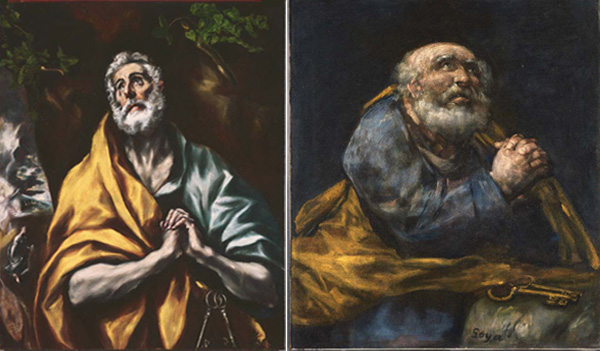
(left) El Greco, The Repentant St. Peter, 1600 - 1605 or later. Oil on canvas, 36 7/8 x 29 5/8 in. The Phillips Collection, Washington, D.C. Acquired 1922; (right) Francisco Jose de Goya, The Repentant St. Peter, circa 1820-1824. Oil on canvas, 28 3/4 x 25 1/4 in. The Phillips Collection, Washington, D.C. Acquired 1936.
The two Repentant Peters are back up, or as Installations Manager Bill Koberg refers to them, Pete and RePete.
Yet the two Saint Peters are hardly alike. The El Greco is elongated, influenced by the icon tradition of his native Crete and the Venetian painters; it flickers with an inner light. The Goya, painted 200 years later, is humanistic, a stocky figure as grounded as the rock he kneels against. The best description of the two Spanish paintings I ever heard was from a visitor: “They look like Don Quixote and Sancho Panza!”
So which one did the real Peter more resemble? Tradition holds that Peter was crucified upside-down during the time of Nero and buried on the Vatican Hill. Early Christians venerated the graves of their martyrs, and the apostle’s final resting place would have been well known. In the 4th century, Constantine the Great built a basilica on Vatican Hill, with the center of the apse and its altar space, with an opening, over the tomb of Saint Peter. A hundred years later, Pope Gregory the Great made the altar bigger and higher over the tomb. Then in the Renaissance, over a period of 150 years, the current church was built, again with the altar area over the tomb.
In the 20th century, Pope Pius XII ordered a full-scale scientific examination of the shrine. From about 1940 to 1957, archeologists excavated beneath the church and found the remains of a 1st century Christian necropolis. Directly beneath the altar area was a grave, with early Christian graffiti scratched into a nearby wall to indicate that it belonged to the apostle Peter. In the tomb were bones, identified as belonging to a man advanced in years, between 60 and 70 years of age, and powerful in build. Both paintings capture Saint Peter’s inner spiritual struggle, but it is Goya’s Repentant St. Peter that provides a more accurate physical depiction of the apostle.
Our humble fisherman, pleading for forgiveness, could not possibly have foreseen a splendid massive basilica, a work of art in itself, built upon the bones of the repentant Saint Peter.
Ianthe Gergel, Museum Assistant

I visted the Philips often in the late ’60s when we lived around the corner. I felt then and still do that Goya’s portrayal is of a very down-to-earth and earthy fellow, looking a lot like the old men I knew when I was young. Right down to the bald pate.
Pingback: Artwork of the Week: Goya's The Repentant Saint Peter - The Art Curator for Kids